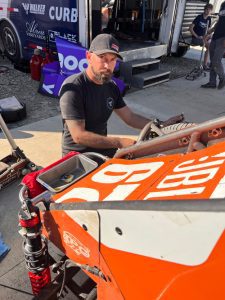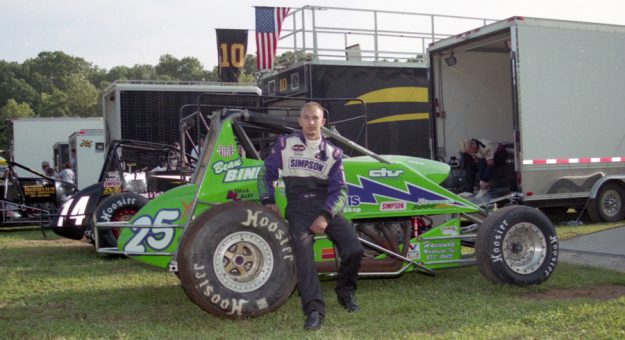As snow flurries fell in central Indiana, Beau Binder could be excused for longing to get to California as soon as possible.
Then reality hit him right between the eyes.
There was a laundry list of things to complete before the Keith Kunz Racing armada headed west. Still as he gazed out the window the scene was nearly hypnotic and provided the perfect backdrop to reminisce.
It’s been nearly two decades since Binder arrived in Indiana from the West Texas town of El Paso. After participating in Indiana Sprint Week as a driver, he figured it was time to make his way to the place he called “the hotbed of racing.” He came with a dream of forging a career in the sport.
Today he can rightfully proclaim that he accomplished his goal, albeit in a manner that deviated from his original plan.
His late father, Ray Binder, was already on the periphery of racing when Binder was born in 1982. Ray Binder was fast friends with Steve Siegel, who was a successful competitor on the Pennsylvania sprint car scene.
At this point, Siegel’s father, Jim, was still an active participant and when he could, Ray Binder tagged along to help.
Beau Binder’s young life would change when a go-kart track was established in nearby Las Cruces, N.M. He was quickly competing, although, with a laugh he calls his early performances “less than extraordinary.” Perhaps it is a fair assessment, but he wasn’t ready to quit by any means. Then he got some interesting new neighbors.
“As luck would have it, two sprint car drivers Dennis Pellicotte and Joe Yearwood moved into places on my street,” Beau says, “Think about it, as big a place as El Paso is and this is where they moved. I started helping them when I wasn’t racing a kart.”
As Binder recalls, Yearwood put his sprint car up for sale and his dad “jumped on it.”
Father and son headed to the annual karting banquet with the intention of selling their equipment. When asked what was next, they reported their intention was to go sprint car racing. Given that Binder was 15 years old, he says, “You would be surprised at the laughs we got.”
Regardless of the detractors, he was ready to give it a go. Racing in a 360 IMCA-sanctioned class he won in just his third outing at the short-lived three-eighths mile Rio Grande Speedway in Santa Teresa, N.M.
While he had plenty of places to race in the region, he quickly began to branch out. His family was all in.
Ray was a lineman for the El Paso Electric Co., while Binder’s mother, Susan, was an administrative assistant at an elementary school. They saw no reason not to combine racing and summer vacations.
On one trip, the Binders traveled to the 360 Nationals at Knoxville (Iowa) Raceway and another excursion incorporated ASCS Speedweek into the agenda.
In 2004, Binder was the USAC Southwest Sprint car champion, and that same summer he competed during Indiana Sprint Week. He had more than just racing on his agenda. Early in his career, he learned a valuable lesson. Fortunately, he also took proactive steps that would pay dividends down the road.
“When I was racing sprint cars, I found out pretty quickly how expensive it was and part of the deal was that my dad had taken a loan out on his 401k, and I had to help pay it back,” Binder explained. “I ended up meeting people who owned Don Davis Race Cars and they hired me. While I was there, I learned to fabricate. I figured I could at least repair my own stuff if necessary.
“I worked there for a couple of years and then I started working at Avenger Chassis building sprint cars. That was really big for me because I ended up getting an Avenger and I could take advantage of some deals on parts.”
With mechanical ability in his back pocket as a trump card, he began plotting a way to remain in the Hoosier state.
“I went to every shop I could to get hired as a fabricator so I could work and bring my car here and still race,” Binder said. “I talked to Keith (Kunz) and Pete (Willoughby) and asked if I could do a welding test for them between race nights. They agreed to do that, and Pete called me before I got back to Texas. I did my final two weeks at Avenger and came back for the rest of the year.
“They asked me if I could work on the cars and I have never really gone back to fabrication.”
Binder still had the itch to compete and eventually got an offer to race a mini sprint for owner Mike Mensendick. In 2012 and 2013, he was the Midwest Mini Sprint Ass’n champion. However, for most of his time in Indiana his primary responsibilities have focused on Keith Kunz Motorsports, where he now has the longest tenure on the team.

Given family responsibilities for many years, he only hit the road for select events. As his children became more self-sufficient, he was free to travel more. Timing is everything, because due to unforeseen circumstances the team needed to lean on him even more.
KKM crew chief Kaz Townsend needed to return to New Zeeland amid the COVID pandemic and once there he had some difficulty getting back to the United States.
To fill the gap, Binder took on more responsibilities with drivers Bryant Wiedeman, Kaylee Bryson, Gavan Boschele and Daison Pursley.
When Townsend returned, there were also changes to the driver roster.
Now Binder focuses his attention on Taylor Reimer, Ryan Timms and Cooper Williams who races a POWRi slate, and he also oversees Buddy Kofoid when the two-time USAC champion returns to the fold.
The verdict?
“I have really enjoyed it,” he said. “It has given me a different perspective and it has made the long road trips more enjoyable. I have been fortunate to build pretty good relationships with all these drivers to help them progress.”
For those on the outside this aspect of the program is less visible.
Racing is about results, but getting those results is a process and one cornerstone is the interactions between a crew chief and the driver. It becomes a challenge on a team with multiple racers and crew chiefs.
“On our team we put 100 percent of our focus on the drivers we are taking care of,” he revealed. “We do interact with the other ones but once hot laps or qualifying starts, unless you see something that really stands out, or there is a crash situation you focus on your drivers.
“That builds that relationship. It’s not necessarily about the setup, it is also about communication and helping them feel comfortable with the car and with us.”
Binder feels one key to the development of a productive bond is the time spent in the aftermath of the race.
“I have three drivers and spend a half hour debriefing with each of them and a lot of times after a bad night it isn’t focusing on what they did wrong but what they could do to not have that happen the next time,” Binder noted. “You try not to point the finger but rather help them realize they can do something better to get the results they want.”
One thing Beau makes clear is that managing emotions and expectations is everyone’s job.
“It’s just not the driver,” he said. “It’s also with the crew. You keep your emotions level. I think one of the biggest things is not getting overly excited when we are doing good and that helps you not get overly disappointed when we are doing bad. This is especially true with kids who are learning.”
Keith Kunz has always felt that it takes three years for the average driver to develop in his program. Interestingly, Binder noted that “It’s not so much that they are starting to click with us, it also means they are starting to click themselves.”
In short, they begin to get it. As an example, he points to the strong year posted by Taylor Reimer. “Right now, Taylor has been on the high point of her midget career,” he said. “She is as good as she has ever been.”
The USAC national midget season may be ending soon, but the important western swing looms ahead. It can be a logistical nightmare, particularly when one considers that KKM will enter a minimum of nine cars from its Columbus, Ind., facility.
“The preparation started a month ago, if not before that,” Beau says, “We make sure that every driver will have a car available to them. That means you are running nine cars for six nights. If you think about it, that is 54 races. That is like a full season. We also make sure to have a backup car for every driver and two more overall backup cars.
“It is a long trip, so we worry about valve springs and just the overall milage on the motors. We don’t want to be in a situation where we are two nights in, and we have to change a motor just because it ran out of miles.
“Then we do maintenance on the trucks and make sure the generators are freshly serviced. So when we get prepared it isn’t just about the race cars it is also about everything rolling down the road on that trip.”
In short order, three full semis, one toterhome with a stacked trailer and two smaller trailers hauling a race car will be headed to California. Binder will be with them. At 41 years old, getting back into a car is not out of the question. However, it would only happen under certain conditions.
“If I could just show up and drive it would be fun,” he says, “but as much as I work on them now, I don’t want to have to prepare a car to do it.”
Like so many before him Binder relocated to Indiana with a strong desire to race.
Summing it all up he simply says, “I ended up taking a different direction.”
He did. Yet, because of his experience he understands the motivations of the young racers that stand before him. Nothing may replace the rush of racing, but he is finding that it is gratifying to help others develop their innate talent.
